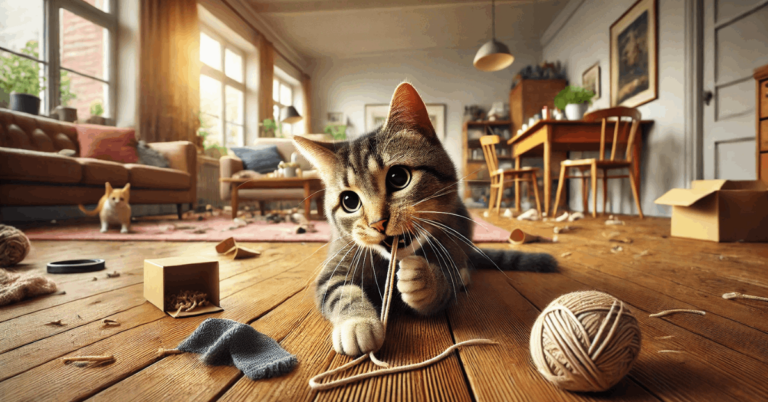Scratching and biting in cats can disrupt daily life, causing stress and potentially harming those around you.
Addressing these habits early creates a calmer and safer environment.
This article outlines practical strategies, environmental adjustments, and professional solutions for stopping cat scratching and biting.
Understanding the Causes
To stop scratching and biting, it’s essential to understand their causes. These behaviors often result from:
- Emotional triggers: Stress, anxiety, or frustration.
- Environmental factors: Lack of stimulation, improper training, or a disruptive environment.
- Physical issues: Health problems like allergies, pain, or discomfort.

The Role of Age in Cat Behavior
A cat’s age significantly affects their scratching and biting tendencies.
Understanding age-specific behaviors helps in choosing the most effective solutions. Here’s how age impacts these habits:
Kittens:
- Scratch and bite are part of natural play and teething.
- Often, they test limits due to curiosity and energy.
- Benefit from redirection with toys and early training.
Adult Cats:
- Scratching is often territorial or stress-related.
- Biting may stem from overstimulation, lack of play, or frustration.
- Require consistent boundaries and adequate mental stimulation.
Senior Cats:
- Scratching may decrease due to reduced activity but can persist for marking territory.
- Biting could indicate discomfort or health issues like arthritis or dental problems.
- Need gentle handling and regular health check-ups.
Behavioral Solutions
Tailor strategies to your cat’s age for better results:
- Kittens: Redirect play aggression with toys, provide teething relief, and establish boundaries early.
- Adult Cats: Increase activity with toys, manage overstimulation, and offer scratching posts.
- Senior Cats: Use gentle play, address health issues causing discomfort, and provide quiet spaces.
Diet and Nutrition’s Role in Behavior
Proper nutrition helps maintain a cat’s physical health and influences their mood and behavior. Here’s how diet and nutrition play a role:
- Balanced diet: Supports a calm, stable mood with all essential nutrients.
- Avoid overfeeding: Prevents hyperactivity and frustration due to excess energy.
- High-quality protein: Promotes energy and reduces irritability.
- Watch for allergies: Food sensitivities can cause discomfort and aggression.
- Regular feeding schedule: Creates a structure and reduces stress.
- Calming supplements: Omega-3s or other calming aids may improve mood.
The Importance of Playtime
Playtime is vital for a cat’s physical health and mental stimulation.
It helps reduce boredom, release pent-up energy, and prevent unwanted behaviors like scratching and biting. Here’s why playtime is essential:
- Burns excess energy: Keeps cats active and prevents destructive habits.
- Reduces stress and anxiety: Provides an outlet for nervous energy.
- Encourages healthy habits: Promotes exercise and improves physical health.
- Strengthens bonds: Builds trust and positive interactions with owners.
- Redirects aggression: Channels biting or scratching into toys, not people or furniture.
- Prevents boredom: Stimulates the mind, reducing frustration and restlessness.
Environmental Adjustments
Creating the right environment is essential for promoting positive behavior.
Simple changes can help reduce triggers and encourage better behavior:
- Reduce stressors: Minimize loud noises, overcrowding, or other stress-inducing elements.
- Provide stimulation: Offer engaging toys, puzzles, or activities to keep the mind and body active.
- Designate safe spaces: Create areas where they can retreat and feel secure.
- Use deterrent tools: Place scratch posts, chew toys, or deterrent sprays to redirect habits.
- Ensure comfort: Adjust bedding, furniture, or surroundings to eliminate physical discomfort.
Medical and Professional Support
When scratching and biting persist despite environmental and behavioral changes, seeking medical or professional support may be necessary.
Experts can help identify and address underlying issues through the following steps:
- Consult a veterinarian: Rule out medical conditions like allergies, pain, or infections.
- Behavioral therapy: Work with a certified behaviorist to develop tailored strategies.
- Training programs: Enroll in professional training sessions for structured guidance.
- Medication or supplements: Explore options for calming anxiety or treating medical issues.
- Regular check-ups: Schedule routine health evaluations to monitor progress.

Long-term Maintenance
Consistency is key to ensuring these behaviors do not return.
Implementing these long-term strategies helps reinforce positive behavior and sustain progress:
- Stay consistent: Apply training methods and rules regularly.
- Monitor behavior: Track changes and identify any recurring triggers.
- Adapt strategies: Adjust approaches based on progress and new challenges.
- Reward positive habits: Continue reinforcing desired actions with rewards.
- Provide ongoing engagement: Keep the environment stimulating with toys and activities.
Preventative Measures
Preventing scratching and biting before they become habits is more straightforward than correcting them later.
Implement these measures early to encourage positive behavior:
- Start training early: Teach acceptable behaviors from the beginning.
- Socialize properly: Expose to various environments and situations to build confidence.
- Provide appropriate outlets: Offer toys or tools for scratching and chewing.
- Set routines: Establish regular schedules for activities and rest.
- Monitor interactions: Supervise during play to prevent accidental reinforcement of bad habits.
Addressing Emotional Triggers
Emotional triggers like stress, anxiety, or fear often lead to these behaviors.
Managing these emotions can help prevent such habits. Consider these approaches:
- Identify stressors: Observe patterns to determine what causes anxiety or fear.
- Create a calming environment: Use soft lighting, soothing sounds, or calming aids to reduce stress.
- Gradual exposure: Slowly introduce triggers in a controlled way to build confidence.
- Increase engagement: Provide regular mental and physical stimulation to distract from emotional distress.
- Use calming products: Explore options like pheromone diffusers, calming sprays, or supplements.
Tools and Aids
Using the right tools and aids can make managing scratching and biting habits easier.
These items can help redirect behavior and protect your surroundings:sfdsfdv
- Scratch posts or pads: Provide designated areas for scratching to prevent damage.
- Chew toys: Offer safe alternatives to satisfy the urge to bite.
- Deterrent sprays: Apply to furniture or objects to discourage unwanted behaviors.
- Protective gear: Use soft nail caps or muzzle guards to limit damage.
- Calming aids: Explore calming collars, pheromone diffusers, or supplements to reduce anxiety.
- Interactive toys: Keep them engaged and distracted with stimulating activities.
Myths and Misconceptions
Misunderstandings about scratching and biting can lead to ineffective approaches or worsened behavior.
Clearing up these myths helps ensure the right strategies are used:
- “It’s just a phase”: Assuming the behavior disappears without intervention.
- “Punishment works best”: Believing harsh discipline stops the behavior instead of escalating it.
- “They’re doing it out of spite”: Misinterpreting the behavior as intentional revenge rather than a response to triggers.
- “It can’t be fixed”: Thinking it’s impossible to change established habits.
- “Medical issues are rare”: Overlooking the possibility of underlying health problems causing the behavior.
Final Takeaways
Addressing scratching and biting in cats requires understanding their causes, tailoring solutions, and staying consistent with efforts.
Implementing the strategies discussed can create a healthier, happier environment for you and your cat.
Start making changes today and help your cat develop positive, lasting behaviors.


